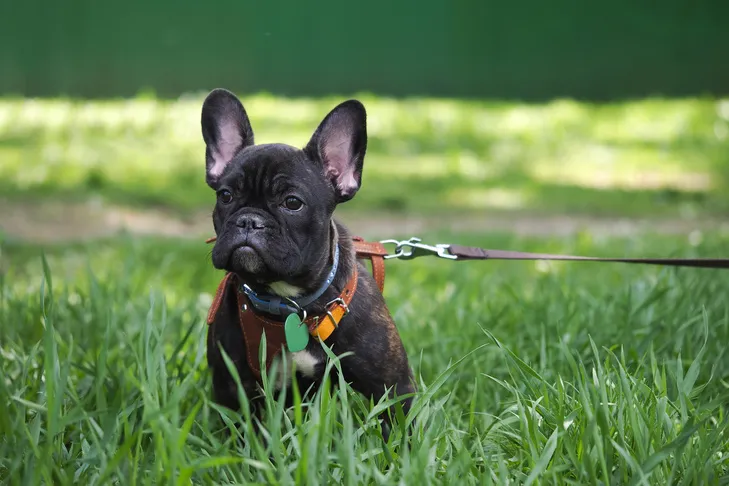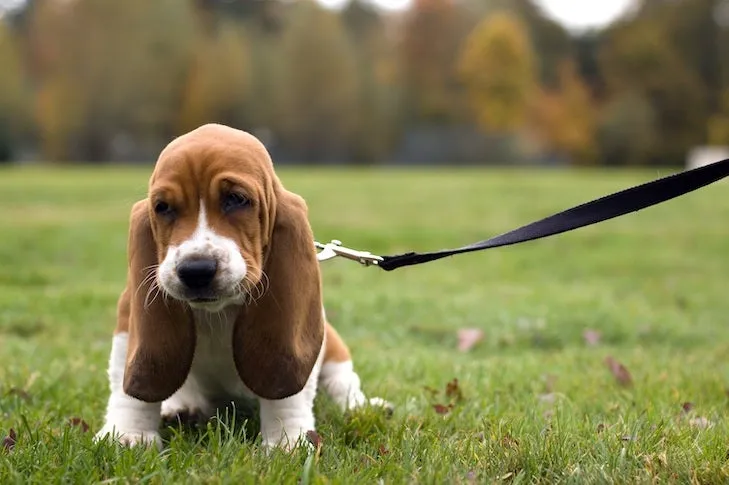Many new dog owners assume that puppies instinctively know how to walk politely on a leash. However, this essential skill is something that must be learned through consistent training. Mastering How To Teach Your Puppy To Walk With A Leash will transform your daily walks into enjoyable experiences for both you and your furry companion, making it one of the most valuable lessons you can impart. Renowned dog training expert and AKC Family Dog columnist Kathy Santo offers invaluable guidance to help you establish a strong foundation for future strolls with your dog. Consider beginning your puppy’s journey with effective training your puppy to walk on a lead to ensure a lifetime of happy and well-behaved walks.
Establishing Leash Walking Fundamentals
Follow these structured steps to lay a solid groundwork for all future walks with your puppy. Each stage is designed to gradually introduce your puppy to the leash and the concept of walking alongside you in a controlled and positive manner.
Introduce the Collar, Harness, and Leash
Begin by familiarizing your puppy with wearing a collar or a harness and a leash. Allow them to wear these items for brief periods inside the house, especially during playtime or when you’re giving them treats. The goal is to create a positive association, so your puppy perceives collar and leash time as synonymous with fun and delicious rewards. This initial exposure should always be a joyful experience, helping them get comfortable before actual training starts.
Teach a Positive Sound Cue
Introduce your puppy to a distinct sound cue that signals, “Food is coming!” This could be a clicker, a specific word like “yes,” or even a tongue cluck. The method remains consistent: in a quiet, distraction-free environment, with your puppy wearing their leash and collar, make the chosen sound. The instant your puppy acknowledges you by turning or looking in your direction, reward them immediately with a treat. After several repetitions, you’ll observe your puppy not only looking at you but actively moving towards you in anticipation of the reward. This cue becomes a powerful tool for communication during training.
 A French bulldog puppy in a comfortable harness sits attentively in tall green grass, ready for a calm walk on its leash.
A French bulldog puppy in a comfortable harness sits attentively in tall green grass, ready for a calm walk on its leash.
Encourage Your Puppy to Come To You
Once your puppy understands the sound cue, encourage them to move towards you. While they are en route, still wearing the leash and collar, back up a few paces. Reward them enthusiastically when they reach you. Gradually increase the distance, continuing this progression until your puppy, upon hearing the cue, comes to you and walks alongside you for a few steps. Remember that puppies have notoriously short attention spans. Keep your training sessions brief and always conclude them when your puppy is still eager and engaged, rather than mentally exhausted. This ensures they maintain a positive outlook on training.
Practice Leash Walking Indoors
With the “come” command firmly established, it’s time to practice walking a few steps in a quiet room with minimal distractions. The sensation and sight of the leash around them will present a sufficient challenge at this stage. Continue to offer treats and praise as your puppy learns to come and walk with you while on the leash. This controlled indoor environment is crucial for building confidence and reinforcing the desired behavior before introducing external stimuli. Patience and positive reinforcement are key to success during these initial indoor sessions.
Transition Training Outdoors
Finally, you’re ready to put your puppy’s newly acquired skills to the test in the great outdoors. This step introduces new challenges, as the myriad of sounds, smells, and sights will undoubtedly be intriguing and novel to your puppy. Maintain patience and keep the initial outdoor walks short. As you walk, remain vigilant. If your puppy appears poised to lunge towards something or is about to become distracted (you’ll notice this by observing their focus shift), promptly make your cue sound and move a few steps away. Reward them with a treat for following you, reinforcing their attention on you despite external temptations.
 A young Basset Hound puppy sits calmly on a green lawn, securely attached to its lead during an outdoor training session.
A young Basset Hound puppy sits calmly on a green lawn, securely attached to its lead during an outdoor training session.
Leash-Training Troubleshooting
Even with thorough initial training, your puppy will likely encounter issues as they mature, explore new environments, and face novel distractions. It’s crucial to teach them loose-leash walking, which is significantly more enjoyable for both of you and a prerequisite for achieving the Canine Good Citizen test. Here are some actionable tips for common leash training difficulties, courtesy of expert trainers.
Addressing Pulling on the Leash
If your dog begins to pull strongly in the opposite direction, transform yourself into an immovable “tree.” Stand perfectly still and refuse to move forward until your dog returns to your side. Avoid yanking or jerking the leash, and never drag your dog along with you. For persistent pullers, alternative training tools such as front-hook harnesses and head halters can be very effective in redirecting their strength and encouraging better manners on a leash. For more specific guidance on this common challenge, learn how to stop puppies from pulling on leash. Additionally, if you have a larger breed, understanding how to stop golden retriever from pulling on leash can provide breed-specific strategies.
Managing Lunging Behavior
If your dog habitually lunges after objects during a walk—be it another dog, a passing car, or a skateboarder—proactive intervention is key. Attempt to redirect their attention with a treat before they have the opportunity to lunge. Increase the physical space between your dog and the provoking target. Stay alert and be prepared to act before the source of their frustration gets too close. While this behavior might be more prevalent in herding breeds due to their strong instincts, any dog can be startled or over-excited by unfamiliar or stimulating sights. In some cases, lunging can be related to high drive, and understanding training prey drive out of dog might offer additional insights.
Handling Excessive Barking on Walks
Some dogs develop a habit of barking excessively at other dogs or stimuli during walks. Often, this behavior stems from insufficient mental and physical exercise. Ensure your dog receives the appropriate amount of stimulation for their age and breed. If the barking persists, employ a similar strategy as you would for lunging: create distance from the trigger and offer treats before they begin to bark. Consistently redirecting their attention towards you whenever they spot another dog will gradually teach them to associate the presence of other dogs with positive rewards and a shift in focus. This helps them learn to manage their excitement and avoid excessive vocalizations, transforming their response from reactive to calm. While not directly addressing aggression, this approach helps manage vocal reactions during walks.
Gradually, you will be able to reduce the frequency of treats and the amount of troubleshooting your puppy requires during walks. It’s always a good practice to keep some treats on hand so you can spontaneously reinforce excellent leash-walking behavior. Consistent positive reinforcement is key to maintaining good habits and strengthening the bond with your well-behaved companion.
